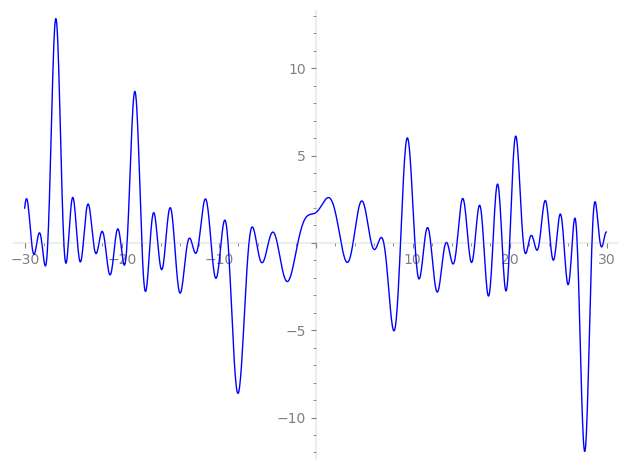| L(s) = 1 | + (1.34 − 0.434i)2-s + (−0.866 + 0.5i)3-s + (1.62 − 1.16i)4-s + (1.44 − 2.49i)5-s + (−0.948 + 1.04i)6-s + (−2.63 + 0.194i)7-s + (1.67 − 2.27i)8-s + (0.499 − 0.866i)9-s + (0.856 − 3.98i)10-s + (2.91 + 5.04i)11-s + (−0.821 + 1.82i)12-s + 1.04·13-s + (−3.46 + 1.40i)14-s + 2.88i·15-s + (1.26 − 3.79i)16-s + (−5.91 + 3.41i)17-s + ⋯ |
| L(s) = 1 | + (0.951 − 0.306i)2-s + (−0.499 + 0.288i)3-s + (0.811 − 0.584i)4-s + (0.644 − 1.11i)5-s + (−0.387 + 0.428i)6-s + (−0.997 + 0.0733i)7-s + (0.593 − 0.805i)8-s + (0.166 − 0.288i)9-s + (0.270 − 1.26i)10-s + (0.878 + 1.52i)11-s + (−0.237 + 0.526i)12-s + 0.290·13-s + (−0.926 + 0.375i)14-s + 0.744i·15-s + (0.317 − 0.948i)16-s + (−1.43 + 0.827i)17-s + ⋯ |
Λ(s)=(=(168s/2ΓC(s)L(s)(0.772+0.635i)Λ(2−s)
Λ(s)=(=(168s/2ΓC(s+1/2)L(s)(0.772+0.635i)Λ(1−s)
| Degree: |
2 |
| Conductor: |
168
= 23⋅3⋅7
|
| Sign: |
0.772+0.635i
|
| Analytic conductor: |
1.34148 |
| Root analytic conductor: |
1.15822 |
| Motivic weight: |
1 |
| Rational: |
no |
| Arithmetic: |
yes |
| Character: |
χ168(19,⋅)
|
| Primitive: |
yes
|
| Self-dual: |
no
|
| Analytic rank: |
0
|
| Selberg data: |
(2, 168, ( :1/2), 0.772+0.635i)
|
Particular Values
| L(1) |
≈ |
1.62745−0.583286i |
| L(21) |
≈ |
1.62745−0.583286i |
| L(23) |
|
not available |
| L(1) |
|
not available |
L(s)=p∏Fp(p−s)−1 | p | Fp(T) |
|---|
| bad | 2 | 1+(−1.34+0.434i)T |
| 3 | 1+(0.866−0.5i)T |
| 7 | 1+(2.63−0.194i)T |
| good | 5 | 1+(−1.44+2.49i)T+(−2.5−4.33i)T2 |
| 11 | 1+(−2.91−5.04i)T+(−5.5+9.52i)T2 |
| 13 | 1−1.04T+13T2 |
| 17 | 1+(5.91−3.41i)T+(8.5−14.7i)T2 |
| 19 | 1+(0.589+0.340i)T+(9.5+16.4i)T2 |
| 23 | 1+(1.85+1.07i)T+(11.5+19.9i)T2 |
| 29 | 1−6.61iT−29T2 |
| 31 | 1+(1.91+3.31i)T+(−15.5+26.8i)T2 |
| 37 | 1+(2.06+1.19i)T+(18.5+32.0i)T2 |
| 41 | 1+1.19iT−41T2 |
| 43 | 1−1.34T+43T2 |
| 47 | 1+(5.52−9.57i)T+(−23.5−40.7i)T2 |
| 53 | 1+(−6.99+4.03i)T+(26.5−45.8i)T2 |
| 59 | 1+(−6.81+3.93i)T+(29.5−51.0i)T2 |
| 61 | 1+(−1.63+2.83i)T+(−30.5−52.8i)T2 |
| 67 | 1+(6.65+11.5i)T+(−33.5+58.0i)T2 |
| 71 | 1−1.08iT−71T2 |
| 73 | 1+(−4.88+2.82i)T+(36.5−63.2i)T2 |
| 79 | 1+(10.9+6.32i)T+(39.5+68.4i)T2 |
| 83 | 1−0.482iT−83T2 |
| 89 | 1+(−10.7−6.19i)T+(44.5+77.0i)T2 |
| 97 | 1+3.63iT−97T2 |
| show more | |
| show less | |
L(s)=p∏ j=1∏2(1−αj,pp−s)−1
Imaginary part of the first few zeros on the critical line
−12.76757748002510149614795482892, −12.06331390313397351244067121741, −10.78622198854137575406187948322, −9.755170721669716510332174880221, −9.035260012394668252276566695807, −6.88025933215595418447040792340, −6.10045177864596035529977108331, −4.87676005778960035245180567586, −3.96907017172117565534504302796, −1.84146809126520651087391505517,
2.62291119429286503342540802073, 3.84652150762071490286595306586, 5.73068001940621656644904799721, 6.44094580446297855935906431891, 7.01279326763343115150200880704, 8.739854365737951880091495453333, 10.22840814143953579564661388607, 11.19971506497024468565252809712, 11.85148126908736759539171116531, 13.40768912663512112008077243502

